Recife metropolitan area
| Recife Metropolitan Area | |
|---|---|
| Metro Area | |
| Nickname(s): RMR | |
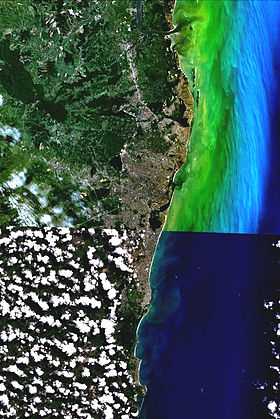 | |
| Country |
|
| Region | Northeast |
| State |
|
| Founded as Metro | June 8, 1973 |
| Recife as Capital | 1837 |
| Area | |
| • Metro | 2,768.9 km2 (1,069.5 sq mi) |
| Population (2011) | |
| • Metro | 3 898 470 |
| Time zone | UTC-3 (UTC-3) |
| HDI (2000) | 0.78 – low |
Recife Metropolitan Area is the largest urban metropolitan area of the Northeast/North regions and the fifth in Brazil with 3,768,902 inhabitants[1] in 2008.Is among with another large cities the first nine established metropolitan regions in Brazil (created by federal supplementary law 14/73 of 8 June 1973). It has one important international airport, two important internationals ports (Suape and Recife), one integrated metro-bus service, many Universities, Hospitals, Museums, Theatres, Historic Monuments, Shopping centers, international Hotels and a large industrial Cluster. Its now passing through a time of economic euphoria in the early construction in the Suape port of a Petrobras refinery, a petrochemical pole and the largest ship builder in South America.I ts area of influence (4th largest in Brazil)[2] covers the entire states of Pernambuco, Paraíba, Alagoas in addition with the interior of the states of Rio Grande do Norte, Piauí, Maranhão, Ceará and Bahia. Its main city is Recife with 1.56 millions inhabitants, capital of Pernambuco.
Cities
According with IBGE is formed by 17 municipalities:
_-_Recife_-_Pernambuco%2C_Brasil.jpg)

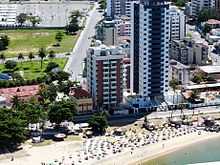
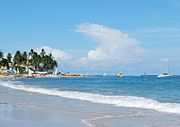
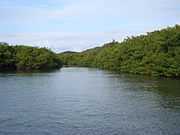
| City | Joint in | Legislation | Area (km²) [3] |
IDH (2000)[4] |
Population (2009)[5] |
GDP (R$ x1000 - 2007).[6] |
|---|---|---|---|---|---|---|
| Abreu e Lima | LCE 10/94 | 125,991 | 94.428 | 0.730 | 747.228 | 7.913,20 |
| Araçoiaba | Instalação do mun. | 96,381 | 18.144 | 0.637 | 54.776 | 3.018,95 |
| Goiana | Instalação do mun. | 501,170 | 75.987 | 0.692 | 634.200 | 8.521,44 |
| Sirinhaém | Instalação do mun. | 378,790 | 40.852 | 0.633 | 183.646 | 4.817,34 |
| Escada | Instalação do mun. | 347,197 | 63.991 | 0.645 | 327.138 | 5.225,51 |
| Cabo de Santo Agostinho | LCF 14/73 | 447,875 | 185.123 | 0.707 | 3.826.487 | 20.699,97 |
| Camaragibe | LCE 10/94 | 55,083 | 144.506 | 0.747 | 618.538 | 4.280,36 |
| Igarassu | LCF 14/73 | 305,565 | 101.987 | 0.719 | 1.057.750 | 10.371,42 |
| Ilha de Itamaracá | LCF 14/73 | 65,411 | 22.449 | 0.743 | 94.137 | 4.193,37 |
| Ipojuca | LCE 10/94 | 527,317 | 80.542 | 0.658 | 7.082.703 | 87.938,01 |
| Itapissuma | LCE 10/94 | 74,249 | 23.723 | 0.695 | 558.915 | 23.560,05 |
| Jaboatão dos Guararapes | LCF 14/73 | 256,073 | 644.699 | 0.777 | 7.068.777 | 10.964,46 |
| Moreno | LCF 14/73 | 195,603 | 56.767 | 0.693 | 257.636 | 4.538,48 |
| Olinda | LCF 14/73 | 43,548 | 377.779 | 0.792 | 2.601.108 | 6.925,96 |
| Paulista | LCF 14/73 | 93,518 | 300.466 | 0.799 | 1.839.666 | 6.119,75 |
| Recife | LCF 14/73 | 217,494 | 1.537.704 | 0.797 | 24.835.340 | 16.058,89 |
| São Lourenço da Mata | LCF 14/73 | 264,346 | 102.956 | 0.707 | 430.601 | 4.182,38 |
| Total | 3147,745 | 3.809.754 | 0.780 | 224.519.764 | 10.845 | |
| Pernambuco | 98.938 | 8.810.256 | 0.705 (0.718 2005) | 62.255.687 | 7.337 |
Transports
International Airport

Guararapes International Airport, also known as Gilberto Freyre International Airport, is the airport serving Recife, has been open in its newest structure since July 2004 and has 52,000 square meters of area. It has the longest runway in the Northeast Region, at 3,305 meters. Its extension permits operations with jumbo jets, such as the Boeing 747-400, which can carry 290 passengers and 62 tons of cargo or Airbus A330/340. Guararapes had its capacity expanded from 1.5 million to 5 million passengers a year which was almost fulfilled in 2008 with more than 4.6 million passengers ( there are also plans to increase to 7.2m ). Current domestic destinations include most major cities in Brazil,and the state cities of Fernando de Noronha and Petrolina; there are also international flights to Lisbon, Paris, Miami, Atlanta, Buenos Aires and Milan .The main airlines operating in Recife Airport include TAM, Gol Transportes Aéreos, TAP Portugal, Delta Air Lines, American Airlines, Livingston Energy Flight, Blue Panorama Airlines, Webjet, TRIP Linhas Aéreas, OceanAir, Flex Linhas Aéreas and Azul Brazilian Airlines.
Suape
A construção do Porto de Suape foi prevista para operar produtos combustíveis e cereais a granel, substituindo o Porto do Recife. Em 7 de novembro de 1978, uma lei estadual criou a empresa Suape Complexo Industrial Portuário para administrar o desenvolvimento das obras. Hoje o porto é um dos maiores do Brasil, administrado pelo governo de Pernambuco. Suape opera navios nos 365 dias do ano, sem restrições de horário de marés. Para auxiliar as operações de acostagem dos navios, o Porto dispõe de um sistema de monitoração de atracação de navios a laser, que possibilita um controle efetivo e seguro, oferecendo ao prático condições técnicas nos padrões dos portos mais importantes do mundo. Suape tem o poder de duplicar a renda de Pernambuco até 2020 e triplicar o PIB até 2030.[7]
O Complexo Industrial Portuário -SUAPE- foi escolhido para a implantação dos seguintes empreendimentos:
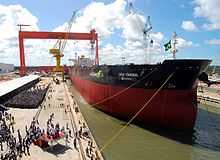
- Refinaria Abreu e Lima;
- Estaleiro Atlântico Sul (maior estaleiro do Hemisfério Sul);
- Estaleiro Promar;
- Petroquímica Suape;
- RM Eolica;
- Gerdau Aços Longos Siderurgia;
- Volskwagen - Montadora;
- Shineray - Montadora;
- BMW - Montadora;
- Hyundai - Montadora;
- Terminal Ferroviario da Transnordestina;
- Central de logística da General Motors;
- Suape Têxtil S/A;
- Braspack Embalagens do Nordeste S/A;
- Amanco do Brasil S/A;
- Termopernambuco S/A;
- Pamesa do Brasil S/A;
- Pepsico do Brasil Ltda;
- Hemobrás - Fábrica de Hemoderivados;
- Novartis - Fábrica de Vacinas;
- Bunge - Moinho;
- Refresco Guararapes Ltda fabricante da coca-cola;
- CSN - Siderúrgica;
- Gerdau - Usina;
- Mossi & Ghisolfi - Fábrica de resina PET;
- Fiat
Ports
Suape port It is located in the city of Ipojuca, inside the metropolitan region. Suape serves ships 365 days a year without any restrictions with regard to tidal schedules. To assist in the docking operation of the ships, the port offers a monitoring system and laser ship docking system that enables effective, secure control and upholds the same technical standards as the most important ports across the globe. The port moves over 8.4 million tons of cargo a year. The liquid granary (petroleum by-products, chemical products, ethanol, vegetable oils, etc.) constitutes more than 80% of the movement. The port can serve ships of up to 170,000 tpb and operational draft of 14.50 m. With 27 km² of backport, the internal and external ports offer the necessary conditions for serving large ships. The access canal has 5,000 m of extension, 300 m in width and 16.5 m in length.More than 95 Companies from almost all Industries are already installed in Suape which includes a Petrobras Refinary, the largest Ship Builder in South American and a large Petrochemical Company as many others.

Port of Recife It is located in the city of Recife. Road access to Port of Recife is accomplished, mainly, through the federal highways BR-232 (linking the interior of the state) and BR-101 (linking to other States to the north and the south of the State of Pernambuco). The main producing and consuming centers of the interior of the state and of the rest of the Northeast, are linked to Port by paved highways. Three trunks of the Railways of Companhia Ferroviária do Nordeste (CFN), Northeastern Railway Company, serve the main areas of production in the state, tying the Port of Recife respectively: to the capitals of the states placed to the north of Pernambuco (north log); to the cities of the interior of the State (log west); and to the cities of Maceió and Aracaju (south log).
Metro Since 1998, the Metro expansion is being built. When ready, Recife Metro will become the second largest in Brazil, after São Paulo.[10] It already reaches from Recife central station to Jaboatão, Timbi (Camaragibe) and Mall (Shopping Recife).
This system also integrates with several bus lines connected to the bus/metro[11] integration terminals, such as Barro and Joana Bezerra stations. It is possible to ride the metro and the connected bus line by purchasing one ticket only. Since March 2009, Recife Metro has finished one more phase of expansion. The system counts now with 28 station (11 integrated with buses) and 39.5 kilometers long. This system for now, crisscrosses 4 cities of the metro area: Recife, Jaboatao, Camaragibe and Cabo (Cabo, just by diesel train).
Fleet
According with Detran-PE (Transportation State Bureau Administrator) in 2009, just the city of Recife has a total fleet of over 464 thousands[12] motor vehicles in its streets. 54.335 Cargo vehicles, 318.520 passengers vehicles, 72.719 motorbikes, 14.142 as other and 4.855 buses (between private and public). Those buses, transports almost two million passengers daily[13][14] in the metropolitan area, distributed between 17 local Bus companies.
Highways
Recife metropolitan area is crisscrossed by 3 main Federal[15] highways:
- BR-101 North - Paraíba and Rio Grande do Norte
- BR-101 South - Alagoas, Bahia, Minas Gerais, Rio de Janeiro, São Paulo, Paraná and Rio Grande do Sul
- BR-232 West - Gravatá, Caruaru, Belo Jardim, Arcoverde, Salgueiro and Parnamirim
- BR-408 NW - Carpina, Timbaúba and Campina Grande
- State Highways PE-xxx: 001/007/009/015/020/022/027/028/035/037/038/041/042/045/060/096
Tourism
During the whole year, Recife is home of many celebrations and events, most of them, religious holidays. The carnival of Recife and Olinda (which has its historic town center considered one of the Brazilian world heritage site by UNESCO in 1982)[16] begins many weeks ahead in December with innumerable balls and processions, as locals begin preparing for the official Carnival, which starts in February. Recife's carnival has the biggest Carnival party in the world, called Galo da Madrugada, but is also known for havving alternative parties for all kind of people, like the parties that happen in Downtown Recife attracting many people from several States of Brazil, and other parts of the world.
Recife got some of the greatest Hotels on Brazil, rated as 4 and 5 stars as well Pousadas (traditional Bed & breakfast) and Apart-Hotels totaling more than 5,500 bedrooms and this number goes to over than 10,000[17] in Recife metropolitan area. Most of all with large experience in reception of Nationals and Internationals tourists and a few ones with Sports complex, Garbage Mount, Baby Pools, etc.
Recife is one of the most cultural sites in Brazil, and is the home of several artists, musicians and writers. It is also home to the frevo, a regional dance and music, typical in the carnival, and the Mangue Beat, a type of Brazilian rock with mixture of Maracatu, Ciranda, Rap and other music styles. Just Recife and Olinda together[18] got 5 museums, 3 Art galleries, 2 Orchestra houses,5 Theatres, 1 Opera House and more than 20 Cinemas.
References
- ↑ IBGE Population 2009
- ↑ Cities Influence Areas
- ↑ IBGE, Área Territorial Oficial, Resolução nº 5 de 10 de outubro de 2002. Acessado em 20 de janeiro de 2008.
- ↑ "Ranking decrescente do IDH-M dos municípios do Brasil". Programa das Nações Unidas para o Desenvolvimento (PNUD). 2000. Retrieved 29 May 2008.
- ↑ Brazil population City by city 2009
- ↑ PIB City by City 2006 IBGE pages 29,30,31
- ↑
- ↑ Fact finding Brazil – Shipyard & Marine visit
- ↑ Qual é o maior metrô do Brasil? (Portuguese)
- ↑ Recife Metro (in Portuguese). Recife, Brazil: Diário de Pernambuco. 2006. ISBN 85-240-3919-1. Archived from the original (PDF) on 2008-02-02. Retrieved 2007-07-18.
- ↑ Recife Metro (in Portuguese). Recife, Brazil: CBTU. 2006. ISBN 85-240-3919-1. Archived from the original (PDF) on 2008-02-02. Retrieved 2007-07-18.
- ↑ http://www.detran.pe.gov.br/download/estatistica/Frota%20registrada%20segundo%20o%20tipo%20-%20Recife.pdf
- ↑ http://blogs.diariodepernambuco.com.br/tecnologia/?p=2229
- ↑ http://jc.uol.com.br/2008/06/27/not_172583.php
- ↑ http://www.aondefica.com/p_atlasflash_pe.asp
- ↑ Olinda - Unesco
- ↑ Miolo_1.pdf Fifa 2014 - Recife
- ↑ Miolo_1.pdf Cultura in Fifa 2014 project page 23